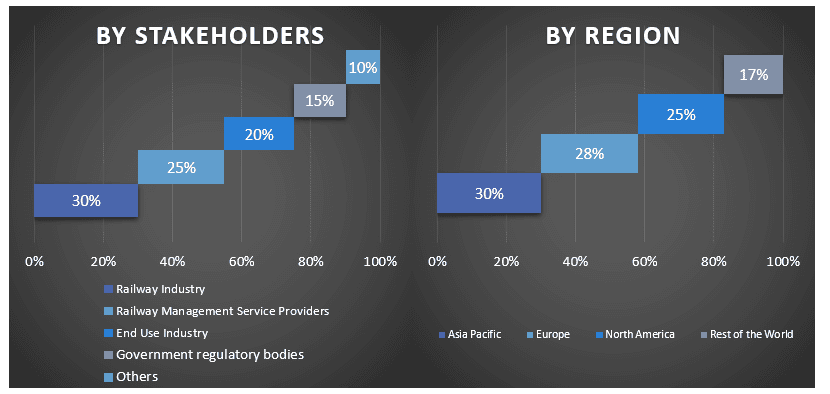- Strona główna
- O nas
- Branża
- Usługi
- Czytanie
- Kontakt
Rynek Systemów Zarządzania Koleją: Aktualna Analiza i Prognoza (2023-2030)
Nacisk na Ofertę (Rozwiązania i Usługi), Wdrożenie (Lokalne i Chmurowe), Komponenty (System Zarządzania Operacjami Kolejowymi, System Zarządzania Ruchem Kolejowym, System Zarządzania Zasobami Kolejowymi, System Sterowania Koleją, System Zarządzania Utrzymaniem Kolei, System Informacji Pasażerskiej i Bezpieczeństwo Kolei), Region/Kraj.

Wartość rynkowa systemów zarządzania koleją wynosi 48 miliardów USD w 2022 r. i oczekuje się, że będzie rosła w tempie CAGR na poziomie 9% w latach 2023-2030.System zarządzania koleją to oparte na oprogramowaniu rozwiązanie zaprojektowane w celu automatyzacji i usprawnienia różnych procesów związanych z zarządzaniem i eksploatacją sieci kolejowej. Pomaga on władzom kolejowym i operatorom w efektywnym zarządzaniu rozkładami jazdy pociągów, sprzedażą biletów, rezerwacjami, utrzymaniem torów, zapasami, informacjami dla pasażerów i innymi powiązanymi działaniami. System zazwyczaj obejmuje moduły do planowania rozkładu jazdy pociągów, sprzedaży biletów, wyświetlania informacji dla pasażerów, zarządzania konserwacją, zarządzania aktywami i raportowania. Ma on na celu poprawę ogólnej wydajności, bezpieczeństwa i jakości usług kolejowych poprzez dostarczanie danych w czasie rzeczywistym, zautomatyzowanych procesów i narzędzi wspomagających podejmowanie decyzji w celu lepszego zarządzania i podejmowania decyzji. Popyt na systemy zarządzania koleją rośnie ze względu na rosnącą infrastrukturę kolejową, liczbę taboru i rosnącą liczbę osób dojeżdżających tym środkiem transportu.
Ponadto rosnący nacisk na zrównoważony rozwój w całej branży sprawia, że koleje stają się głównym nurtem, gdzie koleje są jednymi z najbardziej wydajnych i najmniej emisyjnych środków transportu i są w dużej mierze zelektryfikowane. Na przykład, w 2019 r. IEA (Międzynarodowa Agencja Energetyczna) opublikowała raport, zgodnie z którym koleje przewożą około 8% światowego ruchu pasażerskiego i około 7% ruchu towarowego. Mimo to odpowiada to tylko 2% całkowitej energii zużywanej przez przemysł transportowy. Ponadto, jeśli wszystkie operacje wykonywane obecnie przez koleje zostaną przeniesione na pojazdy drogowe, doprowadzi to do 15% wzrostu całkowitego zużycia ropy i 1,2 gigaton dodatkowych emisji gazów cieplarnianych.
Niektórzy z głównych graczy działających na rynku to Siemens Mobility; Cisco Systems, Inc.; Alstom; Hitachi, Ltd.; Wabtec Corporation.; ABB; IBM; indra; Honeywell International Inc; i Fujitsu.
Informacje przedstawione w raporcie
„Oczekuje się, że zarówno rozwiązania, jak i usługi odnotują znaczny wzrost CAGR w okresie prognozy.”
Na podstawie oferty rynek jest podzielony na rozwiązania i usługi. Oczekuje się, że zarówno rozwiązania, jak i usługi będą się rozwijać w szybkim tempie, ponieważ oba są integralną częścią utrzymania systemu w stanie operacyjnym i działającym w tandemie. Tam, gdzie w rozwiązaniach firmy dostarczają innowacyjne i energooszczędne technologie dla sektora kolejowego, jego produkcji i serwisu wszystkich komponentów i podsystemów w sieciach międzyregionalnych, miejskich i szybkich dla infrastruktury kolejowej i taboru. Ponadto duże zapotrzebowanie jest również na rozwiązania, takie jak rozwiązania w zakresie elektryfikacji, rozwiązania wentylacyjne, systemy trakcyjne i produkty dla taboru itp. Natomiast usługi, takie jak usługi IT i telekomunikacyjne oraz usługi zarządzania obiektami, są również bardzo integralne dla efektywności operacyjnej i łączności oraz dla zwiększenia ogólnej wygody pasażerów, a zatem odgrywają główną rolę w utrzymaniu systemu w stanie operacyjnym i niezawodnym.
„Oczekuje się, że spośród komponentów system informacji pasażerskiej będzie rósł w szybkim tempie CAGR na rynku w prognozowanym okresie.”
Na podstawie komponentów rynek jest podzielony na system zarządzania operacjami kolejowymi, system zarządzania ruchem kolejowym, systemy zarządzania aktywami kolejowymi, system sterowania koleją, system zarządzania konserwacją kolei, system informacji pasażerskiej i system bezpieczeństwa kolei. System informacji pasażerskiej jest najczęściej używanym systemem zarządzania koleją i oczekuje się, że będzie rósł w znacznym tempie CAGR. Godne uwagi rzeczy, które napędzają ten wzrost, to to, że PIS jest interfejsem frontowym między pasażerem a kolejami i pomaga poprawić komfort pasażerów, dostarczając pasażerom informacji w czasie rzeczywistym dotyczących rozkładów jazdy pociągów, opóźnień, numerów peronów i łączności. Pomaga to pasażerom efektywniej planować podróże, zmniejszając frustrację i zamieszanie. Dostępne i dokładne informacje prowadzą do poprawy ogólnego komfortu pasażerów. Ponadto PIS umożliwia efektywne zarządzanie tłumem, dostarczając szczegółowych informacji o obłożeniu pociągów i dostępności miejsc. Pomaga to operatorom kolejowym optymalizować zasoby, równomiernie rozkładać pasażerów w pociągach i zmniejszać zatłoczenie. Ponadto PIS może również przyczynić się do generowania przychodów, oferując ukierunkowane możliwości reklamowe. Dzięki dostępowi do danych i preferencji pasażerów koleje mogą wyświetlać odpowiednie reklamy, promocje lub oferty usług, co pozwala im efektywnie monetyzować swoje platformy cyfrowe.
Pokrycie raportu rynkowego systemu zarządzania koleją

„Azja i Pacyfik zdominowały rynek systemów zarządzania koleją w 2022 r.”
Region Azji i Pacyfiku posiada większość udziału w rynku, a także ma odnotować znaczny wzrost w kategoriach CAGR w prognozowanym okresie. Na przykład, według danych z 2019 r. podanych przez IEA (Międzynarodową Agencję Energetyczną), prawie 90% globalnego ruchu pasażerskiego na konwencjonalnych kolejach odbywa się w tych krajach i regionach, przy czym liderem są Indie z 39%, a następnie Chińska Republika Ludowa (27%), Japonia (11%) i Unia Europejska (9%). Ponadto kraje te również inwestują znacząco w koleje dużych prędkości i metra, przy czym największe inwestycje zostały przejęte przez Chiny, które w ciągu jednej dekady przewyższyły wszystkie inne kraje pod względem długości sieci. Na przykład, według danych z 2019 r. podanych przez IEA, na Chiny przypada około dwóch trzecich działalności związanej z kolejami dużych prędkości, wyprzedzając zarówno Japonię (17%), jak i Unię Europejską (12%). Co więcej, wraz ze wzrostem liczby ludności wzrost ten nie będzie rozłożony równomiernie, a większość wzrostu nastąpi w dużych miastach, co stanowi wyzwanie, ponieważ miasta nie mogą rosnąć geograficznie w nieskończoność, a większe, bardziej zaludnione i bardziej gęste miasta wraz ze wzrostem posiadania pojazdów będą stanowić poważne wyzwanie dla szybkiego, wygodnego i niedrogiego transportu, ponieważ korki będą się nasilać. Ponadto, wraz z rosnącym PKB prawdopodobnie nastąpi ogromny wzrost przewozów towarowych. Aby poradzić sobie z tymi wyzwaniami, kraje w tych regionach muszą znacznie zwiększyć swoją infrastrukturę kolejową, ponieważ jest to wydajny, przyjazny dla środowiska i społecznie korzystny środek transportu o niższej emisji i bezpieczniejszy w podróży, który może pomóc zmniejszyć korki w miastach. Ponadto odpowiedzią na wszystkie te problemy są koleje dużych prędkości, które stanowią wysokiej jakości substytut podróży lotniczych na krótkich dystansach, a także są niezawodną, przystępną cenowo i szybką alternatywą dla podróży drogowych, a także umożliwiają przewóz towarów o dużej ładowności na duże odległości. Wszystkie te czynniki układają się we właściwym kierunku, co buduje idealną sytuację dla kolejnej fazy wzrostu w branży kolejowej, co z kolei napędzi wzrost systemu zarządzania koleją w prognozowanym okresie.
Powody zakupu tego raportu:
- Badanie obejmuje analizę wielkości rynku i prognozowania, zatwierdzoną przez uwierzytelnionych kluczowych ekspertów branżowych.
- Raport przedstawia szybki przegląd ogólnej wydajności branży na pierwszy rzut oka.
- Raport obejmuje dogłębną analizę wybitnych firm z branży, z głównym naciskiem na kluczowe dane finansowe, portfele produktów, strategie ekspansji i najnowsze osiągnięcia.
- Szczegółowe badanie czynników napędzających, ograniczeń, kluczowych trendów i możliwości występujących w branży.
- Badanie kompleksowo obejmuje rynek w różnych segmentach.
- Dogłębna regionalna analiza branży.
Opcje dostosowywania:
Globalny rynek systemów zarządzania koleją można dodatkowo dostosować zgodnie z wymaganiami lub dowolnym innym segmentem rynku. Oprócz tego UMI rozumie, że możesz mieć własne potrzeby biznesowe, dlatego zachęcamy do kontaktu z nami, aby uzyskać raport, który w pełni odpowiada Twoim wymaganiom.
Spis treści
Metodologia badania rynku systemów zarządzania koleją (2023-2030)
Analiza historycznego rynku, szacowanie obecnego rynku i prognozowanie przyszłego rynku globalnego rynku systemów zarządzania koleją to trzy główne kroki podjęte w celu stworzenia i analizy adopcji systemów zarządzania koleją w głównych regionach na całym świecie. Przeprowadzono wyczerpujące badania wtórne w celu zebrania danych historycznych o rynku i oszacowania obecnej wielkości rynku. Po drugie, aby zweryfikować te spostrzeżenia, wzięto pod uwagę liczne ustalenia i założenia. Ponadto przeprowadzono również wyczerpujące wstępne wywiady z ekspertami branżowymi w całym łańcuchu wartości globalnego rynku systemów zarządzania koleją. Po założeniu i walidacji danych rynkowych poprzez wstępne wywiady, zastosowaliśmy podejście odgórne/oddolne do prognozowania całkowitej wielkości rynku. Następnie przyjęto metody podziału rynku i triangulacji danych, aby oszacować i przeanalizować wielkość rynku segmentów i podsegmentów branży. Szczegółowa metodologia jest wyjaśniona poniżej:
Analiza historycznej wielkości rynku
Krok 1: Dogłębne badanie źródeł wtórnych:
Przeprowadzono szczegółowe badanie wtórne w celu uzyskania danych historycznych o wielkości rynku systemów zarządzania koleją z wewnętrznych źródeł firmowych, takich jak raporty roczne i sprawozdania finansowe, prezentacje wyników, komunikaty prasowe itp., oraz ze źródeł zewnętrznych, w tym czasopisma, wiadomości i artykuły, publikacje rządowe, publikacje konkurencji, raporty branżowe, bazy danych stron trzecich i inne wiarygodne publikacje.
Krok 2: Segmentacja rynku:
Po uzyskaniu danych historycznych o wielkości rynku systemów zarządzania koleją przeprowadziliśmy szczegółową analizę wtórną w celu zebrania danych historycznych i udziałów rynkowych dla różnych segmentów i podsegmentów w głównych regionach. Główne segmenty uwzględnione w raporcie według oferty, wdrożenia i komponentu. Ponadto przeprowadzono analizy na poziomie krajów, aby ocenić ogólne przyjęcie modeli testowania w danym regionie.
Krok 3: Analiza czynnikowa:
Po uzyskaniu danych historycznych o wielkości rynku różnych segmentów i podsegmentów przeprowadziliśmy szczegółową analizę czynnikową w celu oszacowania obecnej wielkości rynku systemów zarządzania koleją. Ponadto przeprowadziliśmy analizę czynnikową z wykorzystaniem zmiennych zależnych i niezależnych, takich jak oferta, wdrożenie i komponent rynku systemów zarządzania koleją. Przeprowadzono szczegółową analizę scenariuszy popytowych i podażowych, biorąc pod uwagę najważniejsze partnerstwa, fuzje i przejęcia, ekspansję działalności i wprowadzanie produktów na rynek systemów zarządzania koleją na całym świecie.
Szacowanie i prognozowanie obecnej wielkości rynku
Określanie obecnej wielkości rynku: W oparciu o praktyczne spostrzeżenia z powyższych 3 kroków, doszliśmy do obecnej wielkości rynku, kluczowych graczy na globalnym rynku systemów zarządzania koleją oraz udziałów w rynku poszczególnych segmentów. Wszystkie wymagane udziały procentowe i podziały rynku zostały określone przy użyciu wspomnianego powyżej podejścia wtórnego i zweryfikowane poprzez wstępne wywiady.
Szacowanie i prognozowanie: Do szacowania i prognozowania rynku przypisano wagi różnym czynnikom, w tym czynnikom napędzającym i trendom, ograniczeniom i możliwościom dostępnym dla interesariuszy. Po przeanalizowaniu tych czynników zastosowano odpowiednie techniki prognozowania, tj. podejście odgórne/oddolne, aby dojść do prognozy rynkowej na rok 2030 dla różnych segmentów i podsegmentów na głównych rynkach na całym świecie. Metodologia badawcza przyjęta do oszacowania wielkości rynku obejmuje:
- Wielkość rynku branży pod względem przychodów (USD) i wskaźnik adopcji rynku systemów zarządzania koleją na głównych rynkach krajowych
- Wszystkie udziały procentowe, podziały i rozbicia segmentów rynku i podsegmentów
- Kluczowi gracze na globalnym rynku systemów zarządzania koleją pod względem oferowanych produktów. Również strategie rozwoju przyjęte przez tych graczy, aby konkurować na szybko rozwijającym się rynku
Walidacja wielkości rynku i udziału
Badania pierwotne: Przeprowadzono dogłębne wywiady z kluczowymi liderami opinii (KOL), w tym z kadrą kierowniczą najwyższego szczebla (CXO/VP, szef sprzedaży, szef marketingu, szef operacyjny, szef regionalny, szef krajowy itp.) w głównych regionach. Następnie podsumowano wyniki badań pierwotnych i przeprowadzono analizę statystyczną w celu udowodnienia postawionej hipotezy. Dane wejściowe z badań pierwotnych zostały skonsolidowane z wynikami wtórnymi, przekształcając w ten sposób informacje w praktyczne spostrzeżenia.
Podział uczestników badań pierwotnych w różnych regionach

Inżynieria rynku
Zastosowano technikę triangulacji danych, aby ukończyć ogólne szacowanie rynku i uzyskać dokładne dane statystyczne dla każdego segmentu i podsegmentu globalnego rynku systemów zarządzania koleją. Dane zostały podzielone na kilka segmentów i podsegmentów po przeanalizowaniu różnych parametrów i trendów w obszarach oferty, wdrożenia i komponentów na globalnym rynku systemów zarządzania koleją.
Główny cel badania globalnego rynku systemów zarządzania koleją
W badaniu wskazano obecne i przyszłe trendy na globalnym rynku systemów zarządzania koleją. Inwestorzy mogą uzyskać strategiczne spostrzeżenia, aby oprzeć swoje decyzje inwestycyjne na analizie jakościowej i ilościowej przeprowadzonej w badaniu. Obecne i przyszłe trendy rynkowe określiły ogólną atrakcyjność rynku na poziomie regionalnym, zapewniając uczestnikom przemysłowym platformę do wykorzystania niewykorzystanego rynku w celu skorzystania z przewagi pioniera. Inne cele ilościowe badań obejmują:
- Analiza obecnej i prognozowanej wielkości rynku systemów zarządzania koleją pod względem wartości (USD). Analiza obecnej i prognozowanej wielkości rynku różnych segmentów i podsegmentów
- Segmenty w badaniu obejmują obszary oferty, wdrożenia i komponentów.
- Definiowanie i analiza ram regulacyjnych dla branży systemów zarządzania koleją
- Analiza łańcucha wartości związanego z obecnością różnych pośredników, wraz z analizą zachowań klientów i konkurentów w branży
- Analiza obecnej i prognozowanej wielkości rynku systemów zarządzania koleją dla głównego regionu
- Główne kraje regionów badane w raporcie to Azja i Pacyfik, Europa, Ameryka Północna i reszta świata
- Profile firm z rynku systemów zarządzania koleją i strategie rozwoju przyjęte przez uczestników rynku w celu utrzymania się na szybko rozwijającym się rynku
- Dogłębna analiza branży na poziomie regionalnym
Powiązane Raporty
Klienci, którzy kupili ten przedmiot, kupili również










